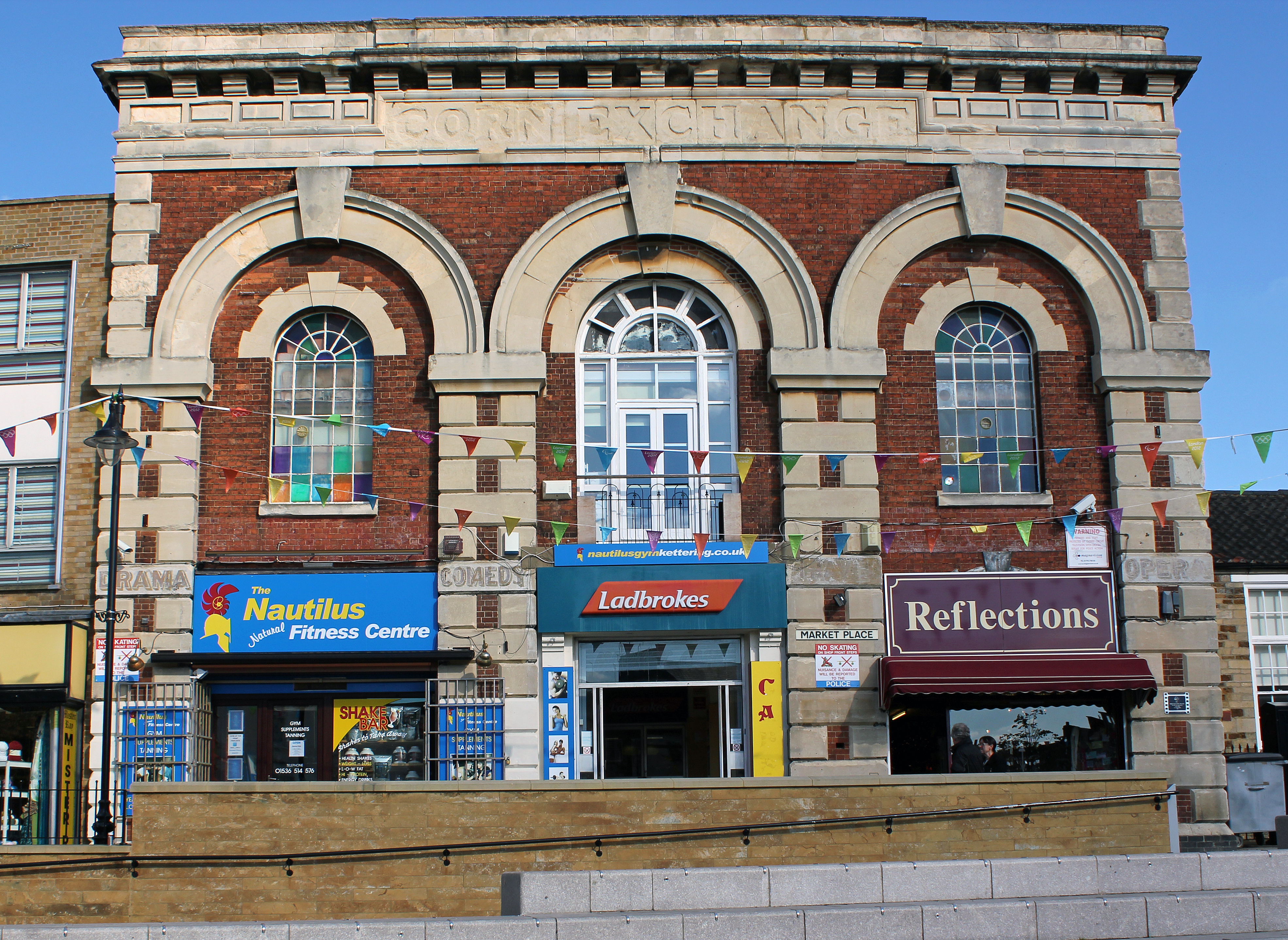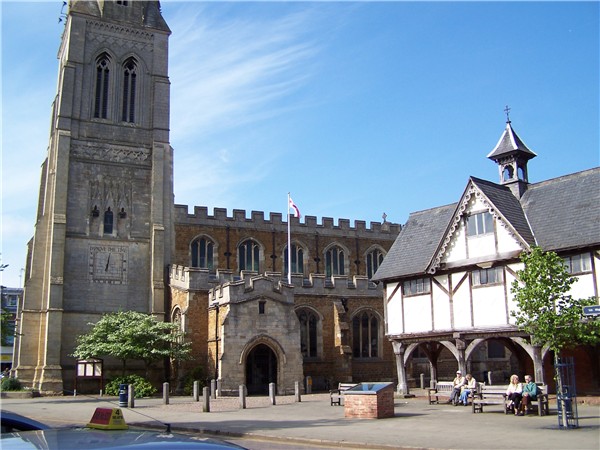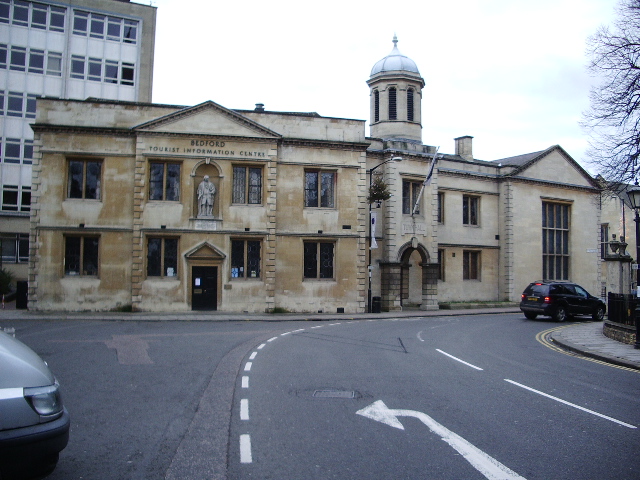|
Desborough
Desborough is a town in Northamptonshire, England, lying in the Ise Valley between Market Harborough and Kettering. It was an industrial centre for weaving and shoe-making in the 19th century and had a long association with the Co-operative movement. Desborough today is a residential centre: new homes and industry are being developed to the north of the old town. History Desborough's origins lie in the Bronze Age of about 2000 BC. Urns from that period have been found in and around the town. Many archaeological finds from the Iron Age and the Anglo-Saxon period have also been made. Some, such as the 1st-century Desborough Mirror and the Anglo-Saxon Desborough Necklace, are now in the possession of the British Museum. Domesday Book (1086) refers to Desborough as a "place of judgement". The name itself is thought to have derived from 'Disburg', which meant a sacred and fortified place. In the High Street centrepiece of what is now the Market Square stands a pillar that is ... [...More Info...] [...Related Items...] OR: [Wikipedia] [Google] [Baidu] |
Desborough Railway Station
Desborough railway station was built by the Midland Railway on its extension from Leicester to Bedford and Hitchin. History The station opened on 8 May 1857 as ''Desborough''. It was renamed on 1 October the same year as ''Desborough for Rothwell.'' On 20 May 1899, Elizabeth Palmer and her five-year-old child, Dixon Palmer, were hit by a fish train whilst crossing the line at the station to get to the opposite platform and killed instantly. By August 1899 the Midland Railway Company had received instructions from the Board of Trade to erect a footbridge over the line. In response to a requisition from the ratepayers of Rothwell, the Midland Railway Company decided to inaugurate a bus service between Rothwell and Desborough station in 1899. The station was renamed ''Desborough and Rothwell'' on 17 October 1899. The station closed in 1968. The station building still stands but the goods yard area is now built-over, mainly given over to a Co-op Food Co-op Food is a bran ... [...More Info...] [...Related Items...] OR: [Wikipedia] [Google] [Baidu] |
Kettering (UK Parliament Constituency)
Kettering is a market and industrial town in North Northamptonshire, England. It is located north of London and north-east of Northampton, west of the River Ise, a tributary of the River Nene. The name means "the place (or territory) of Ketter's people (or kinsfolk)".R.L. Greenall: A History of Kettering, Phillimore & Co. Ltd, 2003, . p.7. In the 2011 census Kettering's built-up area had a population of 63,675. It is part of the East Midlands, along with other towns in Northamptonshire. There is a growing commuter population as it is on the Midland Main Line railway, with East Midlands Railway services direct to London St Pancras International taking about an hour. Early history Kettering means "the place (or territory) of Ketter's people (or kinsfolk)". Spelt variously Cytringan, Kyteringas and Keteiringan in the 10th century, although the origin of the name appears to have baffled place-name scholars in the 1930s, words and place-names ending with "-ing" usually deriv ... [...More Info...] [...Related Items...] OR: [Wikipedia] [Google] [Baidu] |
Rothwell, Northamptonshire
Rothwell is a market town in North Northamptonshire, England. It is close to three larger towns, situated 4 miles .4kmnorthwest of Kettering, 7 miles 1kmsoutheast of Market Harborough and 8 miles 2.8kmsouthwest of Corby. Rothwell's nearest railway station is at Kettering on the Midland Main Line. Rothwell – "the place of the red well" The ridge on which present day Rothwell stands, overlooking the gentle Ise Valley, has witnessed the comings and goings of successive generations. Four thousand years ago Bronze Age mourners buried their dead alongside offerings of food in vessels. The Romano-British people, two thousand years later, built a settlement in what is now ''Rothwell''. Dark Age invaders came next and founded the Danish settlement of "Rodewell" or "place of the red well", presumably so-called because of the area's many freshwater springs coloured red by iron and other minerals. There is an alternative explanation for the name however. According to AD Mi ... [...More Info...] [...Related Items...] OR: [Wikipedia] [Google] [Baidu] |
Northamptonshire
Northamptonshire (; abbreviated Northants.) is a county in the East Midlands of England. In 2015, it had a population of 723,000. The county is administered by two unitary authorities: North Northamptonshire and West Northamptonshire. It is known as "The Rose of the Shires". Covering an area of 2,364 square kilometres (913 sq mi), Northamptonshire is landlocked between eight other counties: Warwickshire to the west, Leicestershire and Rutland to the north, Cambridgeshire to the east, Bedfordshire to the south-east, Buckinghamshire to the south, Oxfordshire to the south-west and Lincolnshire to the north-east – England's shortest administrative county boundary at 20 yards (19 metres). Northamptonshire is the southernmost county in the East Midlands. Apart from the county town of Northampton, other major population centres include Kettering, Corby, Wellingborough, Rushden and Daventry. Northamptonshire's county flower is the cowslip. The Soke of Peterborough fall ... [...More Info...] [...Related Items...] OR: [Wikipedia] [Google] [Baidu] |
Midland Railway
The Midland Railway (MR) was a railway company in the United Kingdom from 1844. The Midland was one of the largest railway companies in Britain in the early 20th century, and the largest employer in Derby, where it had its headquarters. It amalgamated with several other railways to create the London, Midland and Scottish Railway at grouping in 1922. The Midland had a large network of lines emanating from Derby, stretching to London St Pancras, Manchester, Carlisle, Birmingham, and the South West. It expanded as much through acquisitions as by building its own lines. It also operated ships from Heysham in Lancashire to Douglas and Belfast. A large amount of the Midland's infrastructure remains in use and visible, such as the Midland main line and the Settle–Carlisle line, and some of its railway hotels still bear the name '' Midland Hotel''. History Origins The Midland Railway originated from 1832 in Leicestershire / Nottinghamshire, with the purpose of serving the nee ... [...More Info...] [...Related Items...] OR: [Wikipedia] [Google] [Baidu] |
River Ise
The River Ise is a river in Northamptonshire, England and a tributary of the River Nene. The river rises in a field that was part of the site of the Battle of Naseby in north-western Northamptonshire. The parish of Naseby lies across a watershed from which streams also flow to the rivers Avon and Nene. It flows east past Desborough and the Eleanor cross at Geddington, then through the grounds of Rushton Hall, before turning south and passing through the parkland of Boughton House where it was extensively canalised and landscaped in the late 17th century. It then flows between Kettering and Barton Seagrave where its valley was excavated during the creation of Wicksteed Park to provide a large lake for public amenity use. It finishes its journey by flowing past Burton Latimer and Finedon, joining the Nene just south of Wellingborough. Fishing on the Ise The Ise contains many varieties of coarse and game fish, including roach, perch, barbel and chub. It is also the only watercourse ... [...More Info...] [...Related Items...] OR: [Wikipedia] [Google] [Baidu] |
North Northamptonshire
North Northamptonshire is one of two local authority areas in Northamptonshire, England. It is a Unitary authorities of England, unitary authority area forming about one half of the Ceremonial counties of England, ceremonial county of Northamptonshire. It was created in 2021. Its notable towns are Kettering, Corby, Wellingborough, Rushden, Raunds, Desborough, Rothwell, Northamptonshire, Rothwell, Irthlingborough, Thrapston and Oundle. The council is based at the Corby Cube in Corby. It has a string of lakes along the River Nene, Nene Valley Conservation Park, associated Nene Valley Railway, heritage railway, the village of Fotheringhay which has tombs of the House of York as well as a towering church supported by flying buttresses. This division has a well-preserved medieval castle in private hands next to Corby – Rockingham Castle – and about 20 other notable : country houses in Northamptonshire, country houses, many of which have visitor gardens or days. History N ... [...More Info...] [...Related Items...] OR: [Wikipedia] [Google] [Baidu] |
A6 Road (Great Britain)
The A6 is one of the main north–south roads in England. It runs from Luton in Bedfordshire to Carlisle in Cumbria, although it formerly started at a junction with the A1 at Barnet. It is the fourth longest numbered road in Britain; only the A1, A38 and A30 are longer. Running north-west from Luton, the road passes through Bedford, bypasses Rushden, Kettering and Market Harborough, continues through Leicester, Loughborough, Derby and Matlock before passing through the Peak District to Bakewell, Buxton, Stockport, Manchester, Salford, Pendleton, Irlams o' th' Height, Pendlebury, Swinton, Wardley, Linnyshaw, Walkden, Little Hulton, Westhoughton, Chorley, Preston, Lancaster, Kendal and Penrith before reaching Carlisle. South of Derby, the road is paralleled by the M1 motorway; between Manchester and Preston, the M6 and M61 motorways approximate its course; and from Preston to its northern terminus in Carlisle, it is paralleled by the M6 only. Between Der ... [...More Info...] [...Related Items...] OR: [Wikipedia] [Google] [Baidu] |
Market Harborough
Market Harborough is a market town in the Harborough District, Harborough district of Leicestershire, England, in the far southeast of the county, forming part of the border with Northamptonshire. Market Harborough's population was 25,143 in 2020. It is the administrative headquarters of the larger Harborough District. The town was formerly at a crossroads for both road and rail; however, the A6 road (England), A6 now bypasses the town to the east and the A14 road (England), A14 which carries east-west traffic is to the south. Market Harborough railway station is served by East Midlands Railway services on the Midland Main Line with direct services north to Leicester railway station, Leicester, Nottingham railway station, Nottingham, Derby railway station, Derby and Sheffield railway station, Sheffield and south to St Pancras railway station, London St Pancras. Rail services to Rugby railway station, Rugby and Peterborough railway station, Peterborough ended in 1966. Market ... [...More Info...] [...Related Items...] OR: [Wikipedia] [Google] [Baidu] |
British Museum
The British Museum is a public museum dedicated to human history, art and culture located in the Bloomsbury area of London. Its permanent collection of eight million works is among the largest and most comprehensive in existence. It documents the story of human culture from its beginnings to the present.Among the national museums in London, sculpture and decorative and applied art are in the Victoria and Albert Museum; the British Museum houses earlier art, non-Western art, prints and drawings. The National Gallery holds the national collection of Western European art to about 1900, while art of the 20th century on is at Tate Modern. Tate Britain holds British Art from 1500 onwards. Books, manuscripts and many works on paper are in the British Library. There are significant overlaps between the coverage of the various collections. The British Museum was the first public national museum to cover all fields of knowledge. The museum was established in 1753, largely ... [...More Info...] [...Related Items...] OR: [Wikipedia] [Google] [Baidu] |
Bedford
Bedford is a market town in Bedfordshire, England. At the 2011 Census, the population of the Bedford built-up area (including Biddenham and Kempston) was 106,940, making it the second-largest settlement in Bedfordshire, behind Luton, whilst the Borough of Bedford had a population of 157,479. Bedford is also the historic county town of Bedfordshire. Bedford was founded at a ford on the River Great Ouse and is thought to have been the burial place of King Offa of Mercia, who is remembered for building Offa's Dyke on the Welsh border. Bedford Castle was built by Henry I, although it was destroyed in 1224. Bedford was granted borough status in 1165 and has been represented in Parliament since 1265. It is known for its large population of Italian descent. History The name of the town is believed to derive from the name of a Saxon chief called Beda, and a ford crossing the River Great Ouse. Bedford was a market town for the surrounding agricultural region from the early Middle ... [...More Info...] [...Related Items...] OR: [Wikipedia] [Google] [Baidu] |
.jpg)






